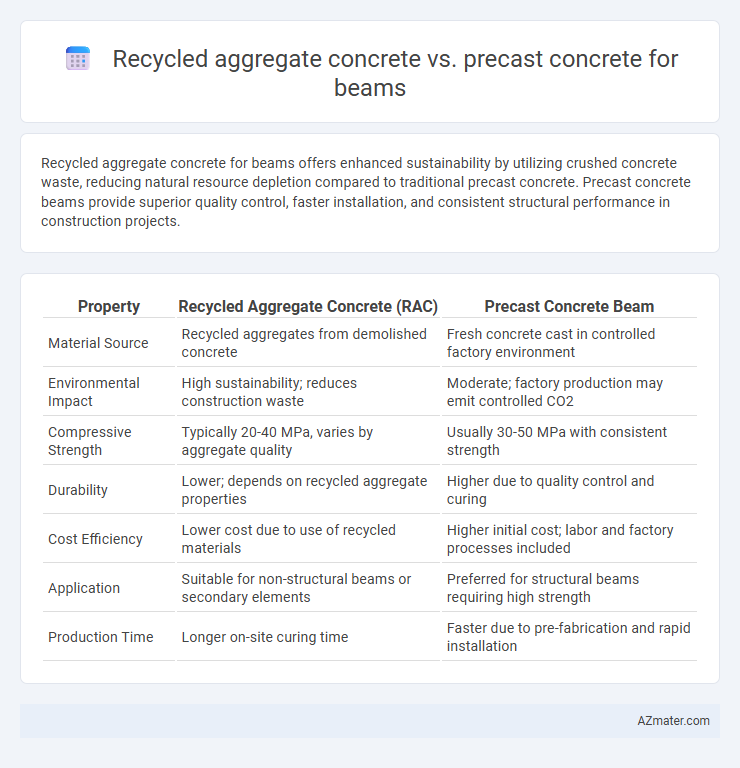Recycled aggregate concrete for beams offers enhanced sustainability by utilizing crushed concrete waste, reducing natural resource depletion compared to traditional precast concrete. Precast concrete beams provide superior quality control, faster installation, and consistent structural performance in construction projects.
Table of Comparison
| Property | Recycled Aggregate Concrete (RAC) | Precast Concrete Beam |
|---|---|---|
| Material Source | Recycled aggregates from demolished concrete | Fresh concrete cast in controlled factory environment |
| Environmental Impact | High sustainability; reduces construction waste | Moderate; factory production may emit controlled CO2 |
| Compressive Strength | Typically 20-40 MPa, varies by aggregate quality | Usually 30-50 MPa with consistent strength |
| Durability | Lower; depends on recycled aggregate properties | Higher due to quality control and curing |
| Cost Efficiency | Lower cost due to use of recycled materials | Higher initial cost; labor and factory processes included |
| Application | Suitable for non-structural beams or secondary elements | Preferred for structural beams requiring high strength |
| Production Time | Longer on-site curing time | Faster due to pre-fabrication and rapid installation |
Introduction to Recycled Aggregate Concrete and Precast Concrete
Recycled aggregate concrete (RAC) incorporates crushed concrete waste as aggregate in new concrete, promoting sustainable construction by reducing natural resource consumption and landfill waste. Precast concrete beams are manufactured off-site under controlled conditions, ensuring high quality, faster construction, and improved structural performance. Comparing RAC and precast concrete for beams highlights differences in material sourcing, environmental impact, and construction efficiency.
Material Composition: Recycled vs Traditional Aggregates
Recycled aggregate concrete (RAC) utilizes crushed concrete and masonry waste as aggregates, replacing traditional natural aggregates commonly found in precast concrete beams. This substitution reduces environmental impact by diverting construction debris from landfills and conserves natural resources, while potentially affecting material properties like density and tensile strength. Precast concrete beams rely on high-quality natural aggregates, ensuring consistent composition and optimal mechanical performance, but with higher ecological costs compared to recycled aggregate variants.
Strength and Durability of Beam Structures
Recycled aggregate concrete (RAC) beams demonstrate comparable compressive strength to traditional precast concrete beams when properly processed, with strength values typically ranging between 25 to 40 MPa depending on the aggregate quality. Durability of RAC beams can be enhanced through techniques such as optimized mix design and surface treatments to mitigate potential porosity and chloride ingress, ensuring resistance to freeze-thaw cycles and corrosion in reinforcement. Precast concrete beams, manufactured under controlled factory conditions, inherently offer high uniformity and durability, with well-documented long service life, but RAC beams provide a sustainable alternative without significant compromise in strength and durability when appropriate standards are maintained.
Environmental Impact and Sustainability
Recycled aggregate concrete (RAC) significantly reduces environmental impact by reusing construction waste, lowering natural resource depletion, and minimizing landfill use, making it a sustainable choice for beam construction. Precast concrete offers energy efficiency through controlled manufacturing processes that reduce waste and improve material performance, but typically relies more on virgin materials compared to RAC. Incorporating recycled aggregates in precast beams can enhance sustainability by combining durability with reduced carbon footprint and resource conservation.
Cost Efficiency and Economic Considerations
Recycled aggregate concrete significantly reduces material costs by utilizing waste aggregates, lowering expenses related to raw materials in beam production. Precast concrete beams, despite higher initial fabrication costs, offer faster installation and reduced onsite labor, leading to overall project savings. Evaluating project scale and local material availability is crucial to determining the most cost-efficient option for structural beam applications.
Construction and Installation Techniques
Recycled aggregate concrete beams require specialized handling to accommodate variability in aggregate quality, often involving extended curing times and additional reinforcement to ensure structural integrity. Precast concrete beams benefit from controlled factory conditions, enabling precise molding, curing, and quality control, which streamline onsite installation through standardized connections and reduced curing delays. Construction with recycled aggregate typically demands more rigorous site quality checks, whereas precast beams allow faster erection and immediate load application, optimizing overall project timelines.
Performance in Structural Applications
Recycled aggregate concrete (RAC) shows comparable compressive strength and durability to traditional precast concrete for beams, making it suitable for structural applications with sustainable benefits. Precast concrete beams offer superior quality control and consistency due to factory production, enhancing load-bearing capacity and reducing construction time. Both materials exhibit effective performance in structural beams, but RAC introduces environmental advantages by utilizing construction waste without significantly compromising mechanical properties.
Quality Control and Consistency
Recycled aggregate concrete (RAC) for beams demands rigorous quality control to address variability in aggregate properties, ensuring consistent strength and durability through careful mix design and frequent testing. Precast concrete beams benefit from controlled factory environments that enable uniform material quality and precise curing conditions, resulting in higher consistency and reduced defects. Both require tailored quality control measures, but precast concrete typically achieves superior consistency due to standardized production processes and continuous monitoring.
Challenges and Limitations
Recycled aggregate concrete (RAC) for beams faces challenges including reduced compressive strength, higher water absorption, and variability in aggregate quality, which can affect structural performance and durability. Precast concrete beams offer uniform quality and faster installation but have limitations related to transportation constraints and connection complexities at construction sites. Both materials require careful design considerations to address these limitations, ensuring safety and long-term serviceability in beam applications.
Future Trends and Innovations in Beam Construction
Recycled aggregate concrete in beam construction is gaining traction due to its sustainability benefits and potential to reduce carbon footprints, with innovations focusing on enhancing durability and bonding properties through advanced admixtures and carbonation curing. Precast concrete beams are evolving with integration of smart sensors and modular design approaches, enabling faster installation and real-time structural health monitoring. Future trends indicate hybrid systems combining recycled aggregates and precast techniques to optimize resource efficiency, performance, and lifecycle costs in beam construction.

Infographic: Recycled aggregate concrete vs Precast concrete for Beam
 azmater.com
azmater.com